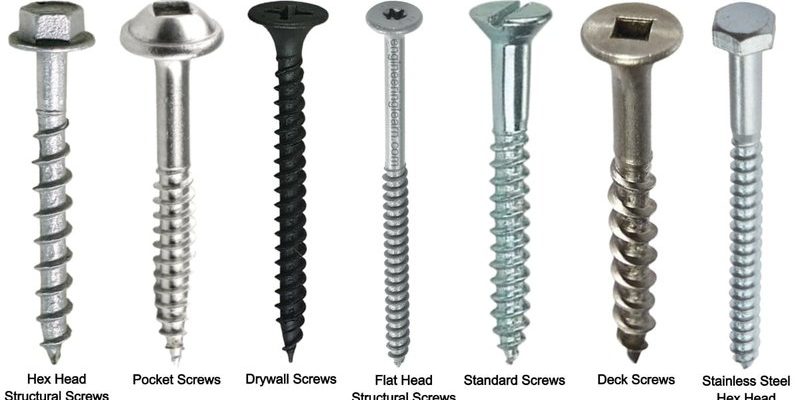
Whether you’re installing a new door, fixing a loose hinge, or adding a lock, the proper wood screw ensures everything stays put and performs well. Here’s the thing: not all screws are made equal. Just like different types of glue serve different purposes, various wood screws are designed for different tasks, materials, and weights. Let’s dive into the different types of wood screws you’ll likely encounter and how they fit into the bigger picture of door hardware.
Understanding Wood Screws
Before we jump into specific types, it’s essential to understand what wood screws are. Wood screws are designed to join two pieces of wood together. They have coarse threads that grip the wood securely, making them ideal for construction and furniture projects.
When you’re selecting a screw, consider the type of wood, the weight of the item, and the environment (indoor or outdoor). These factors will influence your choice. For instance, you wouldn’t want a screw that rusts easily if you’re mounting a door on an exterior wall. That’s where material and finish become essential considerations.
Common Types of Wood Screws
Wood screws come in various shapes and sizes, each with unique properties. Here’s a breakdown of some common types:
- Flat Head Screws: These screws have a flat top and are designed to sit flush with the surface of the wood. They’re great for aesthetic finishes and are often used in cabinetry.
- Pan Head Screws: With a rounded top, pan head screws are useful when a slightly raised head is acceptable. They provide a larger surface area, which can distribute pressure better.
- Round Head Screws: These screws are fully rounded at the top and are often used when the screw head is visible, like in decorative applications.
- Wafer Head Screws: These flat-topped screws have a larger diameter than flat head screws, which helps them hold better in softer woods.
By knowing the types of wood screws, you can choose the right one for your specific project.
Materials: Steel vs. Stainless Steel vs. Brass
The material of your wood screw affects its strength, corrosion resistance, and how well it holds up over time. Here’s a closer look at the three most common materials:
Steel Screws
Steel screws are durable and come in various finishes, but they can rust if exposed to moisture. If you’re working indoors or in a dry environment, steel screws may be the right choice. They’re economical and widely available.
Stainless Steel Screws
Need something tougher? Stainless steel screws resist rust and corrosion, making them ideal for outdoor use. They’re slightly more expensive, but if you’re mounting a door in a moist environment, the investment pays off. Plus, they look great—shiny and new!
Brass Screws
Brass screws offer a unique aesthetic with their golden hue and are often used in decorative projects. However, they’re softer and less durable than steel or stainless steel screws, making them more suitable for light-duty applications.
Thread Types: Coarse vs. Fine
The threads on a wood screw can be coarse or fine, and each type has its purpose.
Coarse Threads
Coarse threads are ideal for softwoods like pine and cedar. They have deeper grooves that can grip more effectively, reducing the chances of splitting. If you’re working with thicker materials, coarse-threaded screws might be your best bet.
Fine Threads
Fine threads work better with hardwoods, such as oak or maple. They’re more prone to pulling out but can create a tighter hold. If you’re attaching heavy hardware to hardwood, fine-thread screws will lock in tightly.
Length and Diameter of Screws
Screw length and diameter play a significant role in the overall strength of your connection. Here’s what to consider:
Screw Length
The length of the screw should penetrate at least half the thickness of the material you’re securing. For example, if your door is 1.5 inches thick, a 1-inch screw will hold adequately but consider going longer for added security.
Diameter
The diameter should suit both the screw’s purpose and the material. A thicker screw can handle more strain but may not fit nicely into smaller fixtures. Finding the right balance is key.
Finishes: Selecting the Right Coating
Different finishes protect your screws and enhance their appearance. Here are a few options:
- Galvanized: Good for outdoor use due to rust protection.
- Black Oxide: Offers a sleek look and protects against corrosion.
- Plain Steel: Ideal for indoor use but lacks weather resistance.
Choosing the right finish not only improves the longevity of your screws but also contributes to the overall aesthetic of your project.
Common Mistakes When Choosing Wood Screws
Even seasoned DIYers can stumble when selecting screws. Here are common pitfalls to avoid:
- Ignoring the wood type: Using the wrong screw type can lead to splitting, unsatisfactory grip, or even damage.
- Over-tightening: This can strip the screw or damage the wood, so always tighten just enough to secure the hardware without forcing it.
- Choosing length without consideration: A screw too short won’t hold well, while one that’s too long may protrude unwantedly.
Awareness of these mistakes can make a big difference in your project’s success.
Final Thoughts
Choosing the right wood screws for door hardware can be daunting, but it doesn’t have to be. Remember, the key components are the type of screw, the material, thread type, length, and finish. Understanding these factors will ensure your doors operate smoothly and look great. So next time you’re screwing in a hinge or lock, take a moment to consider the right fit. Your door—and your project—will thank you!
